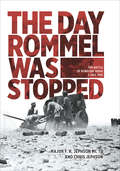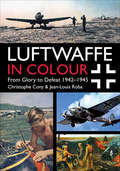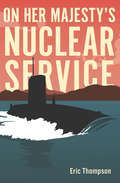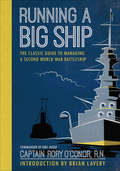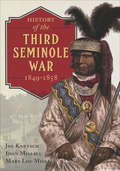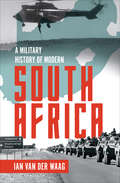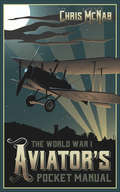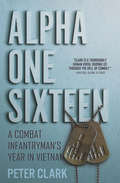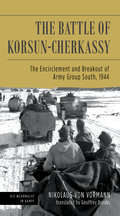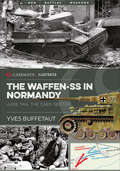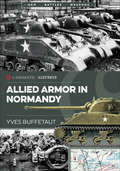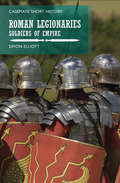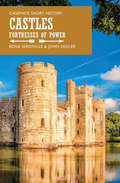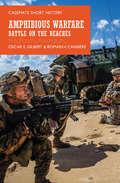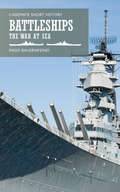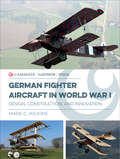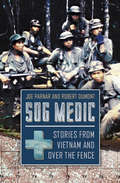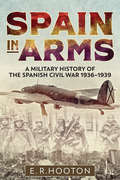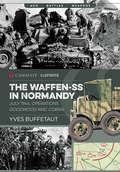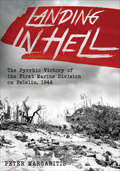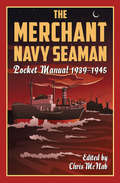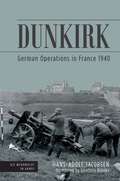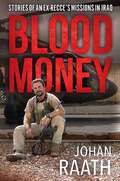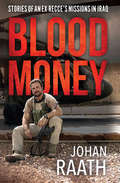- Table View
- List View
The Day Rommel Was Stopped: The Battle of Ruweisat Ride, 2 July 1942
by Chris Jephson Major F. R. JephsonThe true story of a forty-eight-hour showdown and the desperate gamble that prevented the Desert Fox from reaching the Suez Canal—and beyond. Biographer Sir John Wheeler-Bennett once wrote, &“The actual turning of the tide in the Second World War may be accurately determined as the first week of July 1942.&” This book argues that the time may be even more exact: about 2100 hours on July 2, 1942, when Erwin Rommel&’s tanks withdrew for the first time since the fall of Tobruk on June 20, or, arguably, January 14 at El Agheila. At dusk the day before, Rommel had broken through the center of the British defenses at El Alamein. His tanks had overwhelmed the gallant defense of the 18th Indian Infantry Brigade in Deir el Shein at the foot of the Ruweisat Ridge. At that moment, and for the next twelve hours, there was no further organized defense between the spearhead of the Afrika Korps and Alexandria. Throughout the next day, only a handful of men and guns stood between Rommel and his prize. In Cairo, black clouds of smoke from burning files showed that many people believed Rommel would not stop short of the Suez Canal, his stated objective. But on July 3, Rommel called off his attack and ordered his troops to dig in where they stood. The Delta was saved. Just a few weeks earlier, the 18th Indian Infantry Brigade, which took the brunt of the initial attack, and the guns of the small column known as Robcol that stopped Rommel, had been in northern Iraq. Gen. Auchinleck&’s desperate measure, pulling them 1,500 miles from Iraq into the western desert, succeeded—but if Robcol had failed, it is doubtful that Rommel would have stopped at the canal; it does not require much imagination to see his forces threatening to link up with Barbarossa in the Ukraine. This vivid account of the battle of Ruweisat Ridge, the beginning of the battle of Alamein, was written by an officer who was part of Robcol on that fateful day.
Luftwaffe in Colour: From Glory to Defeat
by Christophe Cony Jean-Louis RobaNearly four hundred photos documenting the last years of the Luftwaffe: &“If you&’re interested in unit history then this book is a must have&” (Britmodeller.com). A companion to the first volume of Luftwaffe in Colour, which covered the victory years from 1939 to Spring 1942, this book contains even more fascinating material on the machines of the Luftwaffe and the men who flew them as their fate took an increasingly grim path. Initially, the Luftwaffe ruled the skies, but eventually, they fought an increasingly futile war of attrition that, when combined with vital strategic mistakes in aircraft production, was its death knell. Despite this, the Luftwaffe produced the most successful air aces of all time. Among many remarkable images, we see one of the last Junkers 87 B-2 operational on the Eastern Front during the winter of 1942-1943; the huge BV 222 V-5 of Lufttransportstaffel in the port of Heraklion in late 1942; pilots in Tunisia in 1943; the aces Hans Philipp, Wolfgang Späte, and Heinz Schnaufer; and a vivid demonstration of the reversal in fortunes in 1944 as Allied bombers destroy 106 sites, engulfing them in fire at Schwäbisch Hall on German soil. In this painstakingly curated collection, the full detail behind the propaganda is once more revealed in rare color photographs.
On Her Majesty's Nuclear Service
by Eric ThompsonA journey inside the submarines that patrolled beneath the surface to keep the peace during the Cold War, from a Royal Navy officer and engineer. During the Cold War, nuclear submarines quietly helped prevent a third world war, keeping watch and maintaining the deterrent effect of mutually assured destruction. For security reasons, very few knew the inside stories—until now. Eric Thompson is a career nuclear submarine officer who served from the first days of the Polaris missile boats until after the Cold War, ending up as the top engineer in charge of the Navy&’s nuclear power plants. Along the way, he helped develop all manner of kit, from guided torpedoes to the Trident ballistic missile system. In this vivid personal account of his submarine operations, he reveals what it was like to literally have your finger on the nuclear button. He leads the reader through top-secret submarine patrols, hush-hush scientific trials, underwater weapon developments, public relations battles with nuclear protesters, arm wrestling with politicians, and the changes surrounding gender and sexual preference in the Navy. It is essentially a human story, rich in both drama and comedy, like the Russian spy trawler that played dance music at passing submarines. There was never a dull moment—but it was always a deadly serious game. Among other subjects, Thompson discusses: • The two American nuclear submarines Thresher and Scorpion, which sank with no survivors during the Cold War • The history of submarines, including the Hunley a Confederate submarine during the US Civil War, which was the first sub to ever sink a ship—though it did so kamikaze-style • What a submarine base is like • How a Soviet sub in the Mediterranean was flushed out, earning the crew a crate of champagne from America • The author&’s personal experience with the Polaris and Trident classes of submarine, and more &“Interesting, sometimes thought provoking, but above all an entertaining read.&” —Nuclear Futures
Running a Big Ship: The Classic Guide to Commanding A Second World War Battleship
by Rory O'ConorThe ultimate officers&’ guide from the commander of the HMS Hood. &“A fascinating historical record . . . a first-class textbook for modern managers&” (Baird Maritime). Published in 1937 and now recognized as one of the most influential, yet highly accessible, volumes on naval command and organization, Running a Big Ship provides truly unique insight into life at sea during the Second World War. O&’Conor famously commenced the book with his &“ten commandments,&” a concise code of orders that comprise &“a little that everyone must know.&” The main body of the book sets out each of the duties required of a Royal Navy Officer in detailed, clear terms with O&’Conor&’s insightful advice. Such knowledge ranges from tips on the issuing and execution of orders to attendance requirements, the treatment of defaulters and shipboard theft, midshipmen training, ceremonies, uniforms, cleanliness aboard ship, and the management of the Fleet Air Arm and the high-speed service boats. There are fascinating observations and explanations of the finer points of bugle calls, the treatment of guests, and complete instructions for many forms of recreation from cinema to regattas. Credited with making a significant contribution to the wartime navy&’s esprit de corps, the book had a lasting impact on shipboard understanding and relations for vessels large and small as young, diverse crews withstood the considerable strain of actual war. Running a Big Ship truly sets us below decks and at sea during World War II and includes an extensive introduction by one of the foremost historians of the Royal Navy, Brian Lavery.
History of the Third Seminole War, 1849–1858: 1849-1858
by Joe Knetsch John Missall Mary Lou MissallThis definitive account of the final war between the US government and Florida&’s Seminole tribe &“brings to life a conflict that is largely ignored&” (San Francisco Book Review). Spanning a period of over forty years (1817–1858), the three Seminole Wars were America&’s longest, costliest, and deadliest Indian wars, surpassing the more famous ones fought in the West. After an uneasy peace following the conclusion of the second Seminole War in 1842, a series of hostile events, followed by a string of murders in 1849 and 1850, made confrontation inevitable. The war was also known as the &“Billy Bowlegs War&” because Billy Bowlegs, Holata Micco, was the central Seminole leader in this the last Indian war to be fought east of the Mississippi River. Pushed by increasing encroachment into their territory, he led a raid near Fort Myers. A series of violent skirmishes ensued. The vastness of the Floridian wilderness and the difficulties of the terrain and climate caused problems for the army, but they had learned lessons from the second war, and, amongst other new tactics, employed greater use of boats, eventually securing victory by cutting off food supplies.History of the Third Seminole War is a detailed narrative of the war and its causes, containing numerous firsthand accounts from participants in the conflict, derived from virtually all the available primary sources, collected over many years. &“Any reader interested in learning more about Indian wars, Army history, or Florida history will profit from reading this book,&” as well as Civil War enthusiasts, since many of the officers earned their stripes in the earlier conflict (The Journal of America&’s Military Past).
A Military History of Modern South Africa
by Ian van der WaagThe story of a century of conflict and change—from the Second Boer War to the anti-apartheid movement and the many battles in between. Twentieth-century South Africa saw continuous, often rapid, and fundamental socioeconomic and political change. The century started with a brief but total war. Less than ten years later, Britain brought the conquered Boer republics and the Cape and Natal colonies together into the Union of South Africa. The Union Defence Force, later the SADF, was deployed during most of the major wars of the century, as well as a number of internal and regional struggles: the two world wars, Korea, uprising and rebellion on the part of Afrikaner and black nationalists, and industrial unrest. The century ended as it started, with another war. This was a flash point of the Cold War, which embraced more than just the subcontinent and lasted a long thirty years. The outcome included the final withdrawal of foreign troops from southern Africa, the withdrawal of South African forces from Angola and Namibia, and the transfer of political power away from a white elite to a broad-based democracy. This book is the first study of the South African armed forces as an institution and of the complex roles that these forces played in the wars, rebellions, uprisings, and protests of the period. It deals in the first instance with the evolution of South African defense policy, the development of the armed forces, and the people who served in and commanded them. It also places the narrative within the broader national past, to produce a fascinating study of a century in which South Africa was uniquely embroiled in three total wars.
The World War I Aviator's Pocket Manual (The Pocket Manual Series)
by Chris McNabHow the first military pilots learned to fly—and fight: guidance from Great War training manuals. Aviation was still in its infancy when World War I broke out—and newly formed air forces produced manuals to help pioneers heading for the skies as they took warfare into a new dimension with reconnaissance missions, primitive bombing attempts, and attacks on enemy aircraft. Pulling together information from British manuals such as A Few Hints for the Flying Officer and Practical Flying, as well as American, German, and French training guides, this book shows the type of information the pilots were given, such as: · The basics of how to care for, start, and fly an aircraft · Tactics and strategy in the air · Identifying whether vehicles below were friend or foe · Interacting with mechanics · Coordinating with army or naval forces, and more This fascinating time capsule opens up the world of the Great War aviator and includes introductions to the manuals by Chris McNab, setting them in context and providing background.
Alpha One Sixteen: A Combat Infantryman's Year in Vietnam
by Peter ClarkIn this &“great and necessary addition to the canon of Vietnam War memoirs&” the author &“is a thoroughly human Virgil guiding us through the hell of combat&” (New York Journal of Books). Peter Clark&’s year in Vietnam began in July 1966, when he was shipped out with hundreds of other young recruits as a replacement in the 1st Infantry Division. Assigned to the Alpha Company, Clark gives a visceral and vivid account of life in the platoon as he progresses from green recruit to seasoned soldier over the course of a year. Alpha One Sixteen follows Clark as he discovers how to handle the daily confusion of distinguishing combatants from civilians. The Viet Cong were a largely unseen enemy who fought a guerrilla war, setting traps and landmines everywhere. As he continues his journey, Clark gradually learns the techniques for coping with the daily horrors he encounters, the technical skills needed to fight and survive, and how to deal with the awful reality of civilian casualties. Fighting aside, it rained almost every day, and insect bites constantly plagued the soldiers as they moved through dense jungle, muddy rice paddies, and sandy roads. From the food they ate to the inventive ways they managed to shower—and the off-duty time they spent in the bars of Tokyo—every aspect of the platoon&’s lives is explored in this revealing book. A Military Book Club main selection.
The Battle of Korsun-Cherkassy: The Encirclement and Breakout of Army Group South, 1944 (Die Wehrmacht im Kampf)
by Nikolaus von VormannA primary source account of the WWII Battle of Korsun-Cherkassy written by a Nazi commander who survived the Soviet victory. In 1943, the tide began to turn against Germany on the Eastern Front. Their summer offensive, Operation Citadel, was a failure. The Red Army&’s Dnieper-Carpathian Offensive was pushing back on Germany&’s Army Group South in a war of attrition. By October, Kiev was liberated, and the Soviets had reached the Dnieper River in Ukraine. After sudden attacks by the 1st and 2nd Ukrainian Fronts, the Russians achieved a major encirclement of six German divisions, a total of 60,000 soldiers, in a pocket near the Dnieper River. A dramatic weeks-long battle ensued. After a failed attempt led by Erich von Manstein to break into the pocket from the outside, the trapped German forces focused their efforts on escape. Abandoning equipment and wounded soldiers, the survivors rejoined the surrounding panzer divisions. Beginning with the German retreat to the Dnieper in 1943, Generalleutnant von Vormann chronicles the battle and describes the psychological effects of the brutal combat. As one of the few primary source materials that exists on the subject, this volume is of significant historical interest.
The Waffen-SS in Normandy: June 1944, The Caen Sector (Casemate Illustrated #Cis0003)
by Yves BuffetautThe actions of Germany&’s armed SS force during D-Day in the series that&’s &“a welcome addition . . . targeted at the general World War II enthusiast&” (Globe at War). For many, the Waffen-SS soldier represents the archetype of the combatant, if not the warrior: well-armed, well-trained, possessing intelligence in combat, imbued with political and ideological fanaticism, he is an elite soldier par excellence, even if a lack of scruples casts a long shadow. However, is this picture true? In the case of the Battle of Normandy, opinions diverged, not only among today&’s historians, but also amongst the German generals at the time. In all, the Waffen-SS fielded six divisions during the Battle of Normandy, as well as two heavy battalions of Tiger tanks. But they were by no means a single homogenous entity, for with the exception of II SS-Panzerkorps, the divisions arrived at the front one after another and were immediately thrown into battle. This volume in the Casemate Illustrated series examines the Waffen-SS in Normandy during the fierce fighting of June 1944, when they struggled to hold back the Allied advance on Caen, though the picture was by no means one-sided. Extensively illustrated with photographs, tank profiles, and maps, and accompanied by biographies of key personnel and explanatory text boxes, this volume gives a clear and accessible account of events, challenging some popular perceptions along the way.
Allied Armor in Normandy: Allied And German Forces 1944 (Casemate Illustrated #Cis0004)
by Yves BuffetautTanks were the beasts of the Second World War, machines designed to destroy anything and anyone in their path. Throughout the summer of 1944, the Allied forces readily employed tanks and armored vehicles to gain ground in the bloody campaign of Normandy. Heavily armed, they provided a kind of support which no number of infantrymen could offer, battling their way through enemy lines with their guns blazing. From the US 2nd Armored Division named ‘Hell on Wheels’ to the British ‘Achilles’ tank, the encounters they had in battle were explosive.This volume of the Casemate Illustrated series explores the Normandy invasion from the perspective of the Allied Armored divisions, looking at how armored vehicles played a central role in the many battles that took place. It includes over 40 profiles of tanks and armored vehicles, from the American Sherman and Stuart tanks to the bulldozers and amphibious vehicles designed for the beach.With detailed diagrams and many photos illustrating the composition of the Allied armored divisions and tank regiments present at Normandy, this volume explains the crucial part played by tanks in gaining a foothold in Normandy after the D-Day landings, as well as the significance of many other types of armored vehicles.
From Moscow to Stalingrad: The Eastern Front, 1941-1942 (Casemate Illustrated #Cis0005)
by Yves BuffetautA concise and entertaining history of the Roman legionary—from the age of Augustus through the heyday of the Roman Empire.The might of Rome rested on the back of its legions; the superbly trained and equipped fighting force with which the imperial Roman army conquered, subdued and ruled an empire for centuries. The legionary soldier served for 20 years, was rigorously trained, highly equipped, and motivated by pay, bonuses and a strong sense of identity and camaraderie. Legionaries wore full body-armor and carried a shield, as well as two javelins, a sword, and a dagger. In battle they hurled their javelins and then immediately drew their swords and charged to close combat with the enemy. They were the finest heavy infantrymen of antiquity, and a massed legionary charge was a fearsome sight.In The Roman Legionaries, Simon Elliott, author of Julius Caesar: Rome’s Greatest Warlord, provides an introduction to these elite soldiers, including their training, tactics, weapons, the men themselves, life on and off the battlefield, as well as significant triumphs and disasters in the great battles of the era.
Roman Legionaries: Soldiers of Empire (Casemate Short History)
by Simon ElliottA concise and entertaining history of the Roman legionary—from the age of Augustus through the heyday of the Roman Empire.The might of Rome rested on the back of its legions; the superbly trained and equipped fighting force with which the imperial Roman army conquered, subdued and ruled an empire for centuries. The legionary soldier served for 20 years, was rigorously trained, highly equipped, and motivated by pay, bonuses and a strong sense of identity and camaraderie. Legionaries wore full body-armor and carried a shield, as well as two javelins, a sword, and a dagger. In battle they hurled their javelins and then immediately drew their swords and charged to close combat with the enemy. They were the finest heavy infantrymen of antiquity, and a massed legionary charge was a fearsome sight.In The Roman Legionaries, Simon Elliott, author of Julius Caesar: Rome’s Greatest Warlord, provides an introduction to these elite soldiers, including their training, tactics, weapons, the men themselves, life on and off the battlefield, as well as significant triumphs and disasters in the great battles of the era.
Castles: Fortresses of Power (Casemate Short History)
by John Sadler Rosie SerdivilleThe authors of Knights: Chivalry and Violence let readers inside the walls of the Medieval period’s most iconic structure.In ancient and medieval times castles were the ultimate symbol of power, dominating their surroundings, and marking the landscape with their imposing size and impregnable designs. This concise and entertaining short history explores the life of the castle, one that often involved warfare and sieges. The castle was a first and foremost a fortress, the focus of numerous clashes which took place in the twelfth and thirteenth centuries. Castles became targets of sieges—such as that organized by Prince Louis of France against Dover castle in 1216—and were forced to adopt greater defensive measures. Also explored is how they evolved from motte-and-bailey to stone keep castles, in the face of newly developed siege machines and trebuchets. The trebuchet named Warwolf, which Edward I had assembled for his siege of Scotland’s Stirling Castle, reportedly took three months to construct and was almost four hundred feet tall on completion. With features such as “murder-holes” for throwing boiling oil at the attackers, the defenders in the castle fought back in earnest. Alongside such violence, the castle functioned as a residence for the nobles and their servants, often totaling several hundred in number. It was the location for extravagant banquets held in the great hall by the lord and lady, and the place where the lord carried out his administrative duties such as overseeing laws and collecting taxes.
Amphibious Warfare: Battle on the Beaches (Casemate Short History)
by Oscar E. Gilbert Romain Cansiere&“An easily accessible short history&” of offensive military operations on hostile shores from the authors of First to Fight: The U.S. Marines in World War I (Midwest Book Review). One of the most difficult types of warfare to master, landing on a hostile beach requires scrupulous planning and intense coordination between the air, sea, and land forces. With a history reaching back to the Persians landing on the Greek shores at the Battle of Marathon in 490 BC, it was the First World War that marked the beginning of modern amphibious warfare, with the Royal Marines combining their efforts with the Royal Navy. Despite the disastrous Gallipoli amphibious operation to seize the Dardanelles Straits in 1915, the Royal Navy and US Marine Corps continued to develop new landing crafts through the interwar years. The Second World War proved more successful for amphibious warfare, with the Japanese invasion of the Philippines in 1941 crushing the American forces defending the Pacific islands and the D-Day landings by the Allied troops in 1944 initiating the beginning of the end of the war in Europe. This accessible short history looks at the historical development of amphibious warfare, telling the stories of particular landings and the units that have taken part in this unique type of warfare. The Royal Marines and US Marine Corps continue to evolve and play a crucial role in defense today, with specialized amphibious warfare ships being deployed to enable elite forces to respond promptly to threats across the globe. &“A brief but very useful overview of an important aspect of modern warfare.&” —Baird Maritime
Battleships: The War at Sea (Casemate Short History)
by Ingo BauernfeindAn in-depth analysis of aircraft carrier battles in WWII and the evolution of carrier operations—from technology and strategy to life among the crew.First built in 1921, the aircraft carrier brought a new dimension to military strategy as the United States entered World War II. How Carriers Fought examines the evolution of carrier operations with a special focus on the conflict in the Pacific between the US Navy and the imperial Japanese fleet.Starting with a discussion of the tools and building blocks of carrier operations, historian Lars Celander then provides an analysis of various carrier battles to demonstrate how strategy and operations developed during the war. Every aspect of carrier warfare is covered, from navigation and communication technology to life inside the cockpit. A world of tactical dehydration and amphetamine pills is explored, as well as the measures pilots used to reduce their risk of death in the event of being hit.The major carrier battles of the war are considered, from Coral Sea and Leyte Gulf to the battle of Midway, where the Japanese decided to divide their forces while the Americans concentrated theirs. How Carriers Fought analyzes these tactics, exploring which worked best in theory and in practice.
German Fighter Aircraft in World War I: Design, Construction and Innovation (Casemate Illustrated Special #Ciss0002)
by Mark C. WilkinsThis fully illustrated volume explores German military aviation during WWI through archival photographs and authentically detailed replicas. Fighter aircraft were developed during World War I at an unprecedented rate, as nascent air forces sought to achieve and maintain air supremacy. German manufacturers innovated at top speed, while constantly scrutinizing the development of new enemy aircraft. The Germans also utilized the concept of modular engineering, which allowed them to disassembled or reassembled their aircraft quickly in the field. The pinnacle of their aeronautical innovations was the iconic Fokker D VII—the only aircraft specifically mentioned in the Treaty of Versailles, which forbade Germany from building it after the war. German Fighter Aircraft in World War I explores how German fighter aircraft were developed during the war, the advancements and trials that made the Fokker D VII possible, and the different makes and types of aircraft. Using unpublished images including photographs of surviving aircraft, archive images, and models and replicas, this volume shows details of aircraft that were kept top secret during the war. Extensively illustrated with 140 photos and ten color profiles, this is will be essential reading for all WWI aviation enthusiasts and modelers.
SOG Medic: Stories from Vietnam and Over the Fence
by Robert Dumont Joe ParnarThe “hair-raising details of the second-by-second events” of a Special Forces medic’s covert operations during the Vietnam War (On Point: The Journal of Army History Online).In the years since the Vietnam War, the elite unit known as the Studies and Observations Group (SOG) has spawned many myths, legends, and war stories. Special Forces medic Joe Parnar served with SOG during 1968 in FOB2/CCC near the tri-border region that gave them access to the forbidden areas of Laos and Cambodia. Parnar recounts his time with the recon men of this highly classified unit, as his job involved a unique combination of soldiering and lifesaving. His stories capture the extraordinary commitment made by all the men of SOG and reveal the special dedication of the medics, who put their own lives at risk to save the lives of their teammates. Parnar also discusses his medical training with the Special Forces.“A well-written, interesting account of Parnar’s three-year term of enlistment in the US Army, culminating as a Special Forces medic in Vietnam from 1968 to 1969 . . . Parnar takes the time to provide context, circumstance and motivation for heroism and tragedy—for US soldiers and the indigenous Vietnamese soldiers and civilians with whom he worked . . . The service, sacrifice and valor of a generation are vividly documented in the pages of SOG Medic.” —ARMY Magazine
Spain in Arms: A Military History of the Spanish Civil War, 1936–1939
by E. R. HootonSpain in Arms is a military history of the Spanish Civil War. It examines how the Spanish Civil War developed on the battlefield through the prism of eight campaigns between 1937-1939 and shows how many accounts of military operations during this conflict are based upon half-truths and propaganda. The book is based upon nearly 60 years of extensive research into the Spanish Civil War, augmented by information from specialized German, Italian and Russian works. The Italian campaign against the Basques on the Northern Front in 1937 was one of the most spectacular Nationalist successes of the Civil War, with 60,000 prisoners taken. This is also the first book to quote secret data about Italian air operations intercepted by the British. The figures intercepted by the British show the Italians flew 1,215 sorties and dropped 231 tons of bombs during the campaign, whilst also suffering the heaviest losses. It also demonstrates how the Nationalists won not simply by benefitting from a cornucopia of modern arms from the Fascist powers but by using its limited resources to maximum effect. Spain in Arms reveals the Nationalist battlefield superiority in terms of training and overall command, and the Republic's corresponding weaknesses in the same fields. The Republican Brunete and Belchite offensives of 1937 are described in detail, from the weapons they carried and the tactics they employed to the dynamic Nationalist response and reaction of the generals. This book also explores how the extent of foreign intervention on both sides has been greatly exaggerated throughout history and provides the first accurate information on this military intervention, using British and French archives to produce a radically different but more accurate account of the battles and the factors and men who shaped them. Hooton finally gives the historical context and operational implications of the battlefield events to provide a link between the First and Second World Wars.
The Waffen-SS in Normandy: July 1944, Operations Goodwood and Cobra (Casemate Illustrated #Cis0009)
by Yves BuffetautOne of the greatest paradoxes of the Battle of Normandy is that the German divisions found it much harder to reach the front line than the Allies, who had to cross the sea and then deploy in a cramped bridgehead until the American breakthrough of late July 1944. The Waffen-SS were no better off than the Heer units and German high command never quite got on top of operations, as the divisions were thrown into the melee one by one. During the month of June 1944, the Panzer divisions present succeeded in containing the Allies in a small bridgehead. In July, the arrival of more SS divisions should have finally allowed the Germans to counter-attack decisively. This was not the reality. The Allies had also strengthened in number and kept the blows coming, one after another. Each SS-Panzer division had a different experience of the fighting in July. This Casemate Illustrated looks at the divisions one by one throughout Operations Goodwood and Cobra which saw large tank battles and the collapse of the German front in Normandy. It includes over 100 photographs, alongside biographies of the commanders and color profiles of trucks and tanks which played a key role in operations as the Americans succeeded in breaking through the German line of defense.
Landing in Hell: The Pyrrhic Victory of the First Marine Division on Peleliu, 1944
by Peter MargaritisA detailed history and analysis of the most controversial amphibious operation in the Pacific during WWII: the Battle for Peleliu. On September 15, 1944, the United States invaded the tiny Pacific island of Peleliu, located at the southern end of the Palau Islands. Boasting a large airfield from which the Americans could mount bomber campaigns, Peleliu was a strategically essential part of Gen. MacArthur&’s long-awaited liberation of the Philippines. With the famed 1st Marine Division making the amphibious assault, Pacific High Command was confident that victory would be theirs in just a few days. They were drastically wrong. A mere week after landing, having sustained terrific losses in fierce combat, the 1st Marine Regiment was withdrawn. The entire division would be out of action for six months after sustaining the highest unit losses in Marine Corps history. This book analyzes the many things that went wrong in the Battle for Peleliu, and in doing so, corrects several earlier accounts of the campaign. It includes a comprehensive account of the presidential summit that determined the operation, details of how new weapons were deployed, a new enemy strategy, and command failure in what became the most controversial amphibious operation in the Pacific during WWII.
The Merchant Navy Seaman Pocket Manual 1939–1945 (The Pocket Manual Series)
by Chris McNabA view into the world of the intrepid but often forgotten seamen who helped the Allies win WWII. They may not have worn gold braid or medals, but the Allied Merchant Navies in World War II provided a vital service to their countries&’ war efforts. Hundreds of thousands of British and American sailors—some as young as fourteen—faced considerable risks to maintain an essential flow of armaments, equipment, and food: submarines, mines, armed raiders and destroyers, aircraft, kamikaze pilots, and the weather itself. Life on board a merchant ship could be tense, with hour after hour spent battling high seas, never knowing if a torpedo was about to hit. In the Arctic convoys, sailors had to cope with extreme cold and ice. But there was also comradeship and more open society than was the norm at the time, free of distinctions of class, race, religion, age, or color, and a mixture of nationalities, especially in the British fleet. The Merchant Navy Seaman Pocket Manual provides a fascinating glimpse into the world of these brave sailors, many of whom did not return. Drawing on documents, diagrams, and illustrations from British and American archives, it combines information on training, gunnery, convoys, and antisubmarine techniques with dramatic personal accounts. Covering the Battle of the Atlantic, the Arctic Convoys, and the Pacific, this book pitches the reader into the heart of this vital but often forgotten arena of WWII.
Dunkirk: German Operations in France, 1940 (Die Wehrmacht im Kampf)
by Hans-Adolf JacobsenThe German Army invaded France on 10 May 1940, and in just over ten days their rapid advance, led by three panzer corps, had left three French field armies, Belgian forces and the British Expeditionary Force with their backs to the sea, trapped along the northern coast of France. General Gort realized that evacuation was the only option, and so began a chaotic withdrawal towards the port of Dunkirk. While the Luftwaffe continued to attack pockets of Allied forces, the German ground forces were ordered to halt their advance on 22 May. These orders were changed four days later, but these crucial four days of inaction allowed the Allies time to retreat into Dunkirk and prepare a defensive perimeter. The fighting during the last days of May was desperate, with the remnants of the French First Army surrounded at Lille, holding off seven German divisions until finally forced to surrender, and the Belgian Army forced to capitulate to the east of Dunkirk. Though the cost was devastatingly high, Dunkirk was held long enough for over 300,000 Allied troops to be evacuated back to England, with the remainder of the rearguard of French troops surrendering on 4 June. The British narrative of the retreat and evacuation that prompted perhaps Winston Churchill's most famous wartime speech has always been well-known; however only now is Hans-Adolf Jacobsen's detailed account of the battle from the German perspective available in English.
Blood Money: Stories Of An Ex-Recce's Missions In Iraq
by Johan Raath‘I remember the cracking sound of the AK-47 bullets as they tore through our windscreen . . . A piece of bullet struck my bulletproof vest in the chest area and another piece broke off and lodged in my left forearm.’ <P><P> Johan Raath and a security team were ambushed in May 2004 while on a mission to reconnoitre a power plant south of Baghdad for an American firm. He had been in the country for only two weeks. This was a taste of what was to come over the next few years as he worked as a private military contractor (PMC) in Iraq. <P><P> His mission? Not to wage war but to protect lives. Raath and his team provided security for engineers working on reconstruction projects in Iraq. Whether in the notorious Triangle of Death, in the deadly area around Ramadi or in the faction-ridden Basra, Raath had numerous hair-raising experiences. <P><P> Key to his survival was his training as a Special Forces operator, or Recce. <P><P> This riveting account offers a rare glimpse into the world of private military contractors and the realities of everyday life in one of the world’s most violent conflict zones.
Blood Money: Stories of an Ex-Recce's Missions in Iraq
by Johan RaathA former Special Forces soldier—and presidential bodyguard—shares heart-stopping stories of his time as a private military contractor in Iraq.“I remember the cracking sound of the AK-47 bullets as they tore through our windscreen . . . A piece of bullet struck my bulletproof vest in the chest area and another piece broke off and lodged in my left forearm.”Johan Raath and a security team were ambushed in May 2004 while on a mission to reconnoiter a power plant south of Baghdad for an American firm. He had been in the country for only two weeks. This was a taste of what was to come over the next few years as he worked as a private military contractor (PMC) in Iraq.His mission? Not to wage war, but to protect lives. Raath and his team provided security for engineers working on reconstruction projects in Iraq. Whether in the notorious Triangle of Death, in the deadly area around Ramadi, or in the faction-ridden Basra, Raath had numerous hair-raising experiences.Key to his survival was his training as a Special Forces operator, or Recce.This riveting account offers a rare glimpse into the world of private military contractors and the realities of everyday life in one of the world’s most violent conflict zones.
